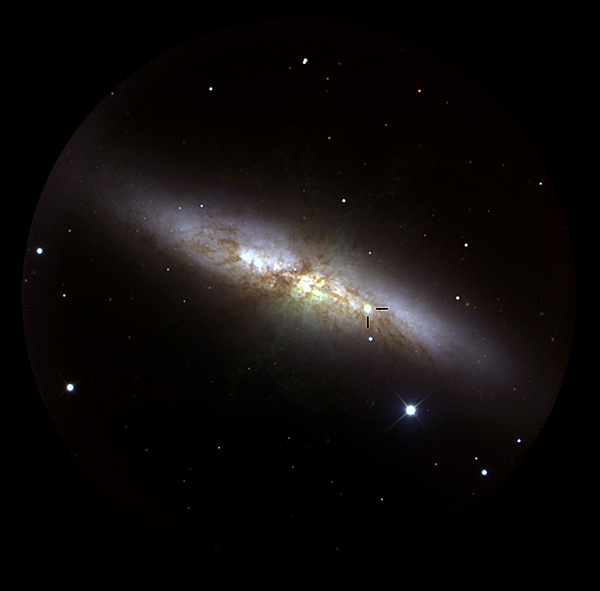 |
Supernova SN2014J in M82. Image obtained using ACAM on the William Herschel Telescope on the 21st of February through filters Sloan i (4×15s, coded as red), Sloan r (4×15s, green), and Sloan g (4×15s, blue). Image processing was performed using IRAF and FITS Liberator, and RGB composition and filtering was done using MATLAB.
Credits: Elizabeth A. Cooke (Nottingham), Nina Hatch (Nottingham), Teo Mocnik (ING) [ JPEG | TIFF ].
|
On the 21st January 2014 astronomers reported the discovery of supernova SN2014J which reached its peak brightness on the 31st January. Some days later, this type Ia supernova started to fade. The image above demonstrates that SN2014J (marked with black lines) continued to be the brightest optical object in the galaxy even one month after the discovery.
The edge-on spiral galaxy M82 lies in the constellation Ursa Major at a distance of 3.5 Mpc. It has long been believed to be an irregular galaxy, however, the discovery of two symmetric spiral arms in 2005 classified the galaxy as a spiral. The observed excessive starburst rates in M82 are believed to be caused by its gravitational interaction with the neighbouring galaxy M81. This interacting starburst galaxy therefore appears brighter than similar non-starburst galaxies. In addition, starbursts drive outflows of ionized material, which is also clearly noticeable in the image above as a nebular feature perpendicular to the galactic plane.
ACAM is an imager and a low-resolution spectrograph mounted at a folded Cassegrain focus of the 4.2m William Hershel Telescope. Commissioned in 2009, ACAM can be used for broad- and narrow-band imaging providing a circular 8.3-arcmin field of view.
More information:



